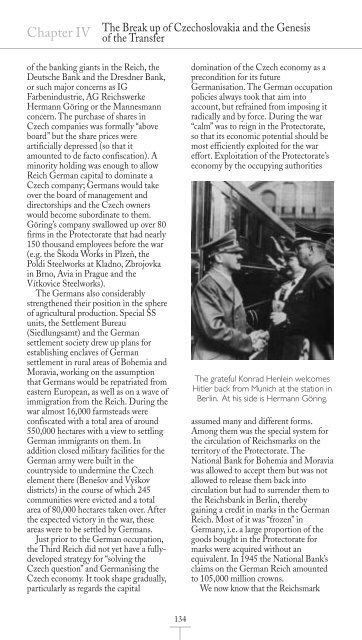the nationality of all inhabitants of the czech provinces and ...
the nationality of all inhabitants of the czech provinces and ...
the nationality of all inhabitants of the czech provinces and ...
You also want an ePaper? Increase the reach of your titles
YUMPU automatically turns print PDFs into web optimized ePapers that Google loves.
Chapter IV<br />
<strong>of</strong> <strong>the</strong> banking giants in <strong>the</strong> Reich, <strong>the</strong><br />
Deutsche Bank <strong>and</strong> <strong>the</strong> Dresdner Bank,<br />
or such major concerns as IG<br />
Farbenindustrie, AG Reichswerke<br />
Hermann Göring or <strong>the</strong> Mannesmann<br />
concern. The purchase <strong>of</strong> shares in<br />
Czech companies was form<strong>all</strong>y “above<br />
board” but <strong>the</strong> share prices were<br />
artifici<strong>all</strong>y depressed (so that it<br />
amounted to de facto confiscation). A<br />
minority holding was enough to <strong>all</strong>ow<br />
Reich German capital to dominate a<br />
Czech company; Germans would take<br />
over <strong>the</strong> board <strong>of</strong> management <strong>and</strong><br />
directorships <strong>and</strong> <strong>the</strong> Czech owners<br />
would become subordinate to <strong>the</strong>m.<br />
Göring’s company sw<strong>all</strong>owed up over 80<br />
firms in <strong>the</strong> Protectorate that had nearly<br />
150 thous<strong>and</strong> employees before <strong>the</strong> war<br />
(e.g. <strong>the</strong> Škoda Works in Plzeň, <strong>the</strong><br />
Poldi Steelworks at Kladno, Zbrojovka<br />
in Brno, Avia in Prague <strong>and</strong> <strong>the</strong><br />
Vítkovice Steelworks).<br />
The Germans also considerably<br />
streng<strong>the</strong>ned <strong>the</strong>ir position in <strong>the</strong> sphere<br />
<strong>of</strong> agricultural production. Special SS<br />
units, <strong>the</strong> Settlement Bureau<br />
(Siedlungsamt) <strong>and</strong> <strong>the</strong> German<br />
settlement society drew up plans for<br />
establishing enclaves <strong>of</strong> German<br />
settlement in rural areas <strong>of</strong> Bohemia <strong>and</strong><br />
Moravia, working on <strong>the</strong> assumption<br />
that Germans would be repatriated from<br />
eastern European, as well as on a wave <strong>of</strong><br />
immigration from <strong>the</strong> Reich. During <strong>the</strong><br />
war almost 16,000 farmsteads were<br />
confiscated with a total area <strong>of</strong> around<br />
550,000 hectares with a view to settling<br />
German immigrants on <strong>the</strong>m. In<br />
addition closed military facilities for <strong>the</strong><br />
German army were built in <strong>the</strong><br />
countryside to undermine <strong>the</strong> Czech<br />
element <strong>the</strong>re (Benešov <strong>and</strong> Vyškov<br />
districts) in <strong>the</strong> course <strong>of</strong> which 245<br />
communities were evicted <strong>and</strong> a total<br />
area <strong>of</strong> 80,000 hectares taken over. After<br />
<strong>the</strong> expected victory in <strong>the</strong> war, <strong>the</strong>se<br />
areas were to be settled by Germans.<br />
Just prior to <strong>the</strong> German occupation,<br />
<strong>the</strong> Third Reich did not yet have a fullydeveloped<br />
strategy for “solving <strong>the</strong><br />
Czech question” <strong>and</strong> Germanising <strong>the</strong><br />
Czech economy. It took shape gradu<strong>all</strong>y,<br />
particularly as regards <strong>the</strong> capital<br />
The Break up <strong>of</strong> Czechoslovakia <strong>and</strong> <strong>the</strong> Genesis<br />
<strong>of</strong> <strong>the</strong> Transfer<br />
134<br />
domination <strong>of</strong> <strong>the</strong> Czech economy as a<br />
precondition for its future<br />
Germanisation. The German occupation<br />
policies always took that aim into<br />
account, but refrained from imposing it<br />
radic<strong>all</strong>y <strong>and</strong> by force. During <strong>the</strong> war<br />
“calm” was to reign in <strong>the</strong> Protectorate,<br />
so that its economic potential should be<br />
most efficiently exploited for <strong>the</strong> war<br />
effort. Exploitation <strong>of</strong> <strong>the</strong> Protectorate’s<br />
economy by <strong>the</strong> occupying authorities<br />
The grateful Konrad Henlein welcomes<br />
Hitler back from Munich at <strong>the</strong> station in<br />
Berlin. At his side is Hermann Göring.<br />
assumed many <strong>and</strong> different forms.<br />
Among <strong>the</strong>m was <strong>the</strong> special system for<br />
<strong>the</strong> circulation <strong>of</strong> Reichsmarks on <strong>the</strong><br />
territory <strong>of</strong> <strong>the</strong> Protectorate. The<br />
National Bank for Bohemia <strong>and</strong> Moravia<br />
was <strong>all</strong>owed to accept <strong>the</strong>m but was not<br />
<strong>all</strong>owed to release <strong>the</strong>m back into<br />
circulation but had to surrender <strong>the</strong>m to<br />
<strong>the</strong> Reichsbank in Berlin, <strong>the</strong>reby<br />
gaining a credit in marks in <strong>the</strong> German<br />
Reich. Most <strong>of</strong> it was “frozen” in<br />
Germany, i.e. a large proportion <strong>of</strong> <strong>the</strong><br />
goods bought in <strong>the</strong> Protectorate for<br />
marks were acquired without an<br />
equivalent. In 1945 <strong>the</strong> National Bank’s<br />
claims on <strong>the</strong> German Reich amounted<br />
to 105,000 million crowns.<br />
We now know that <strong>the</strong> Reichsmark


